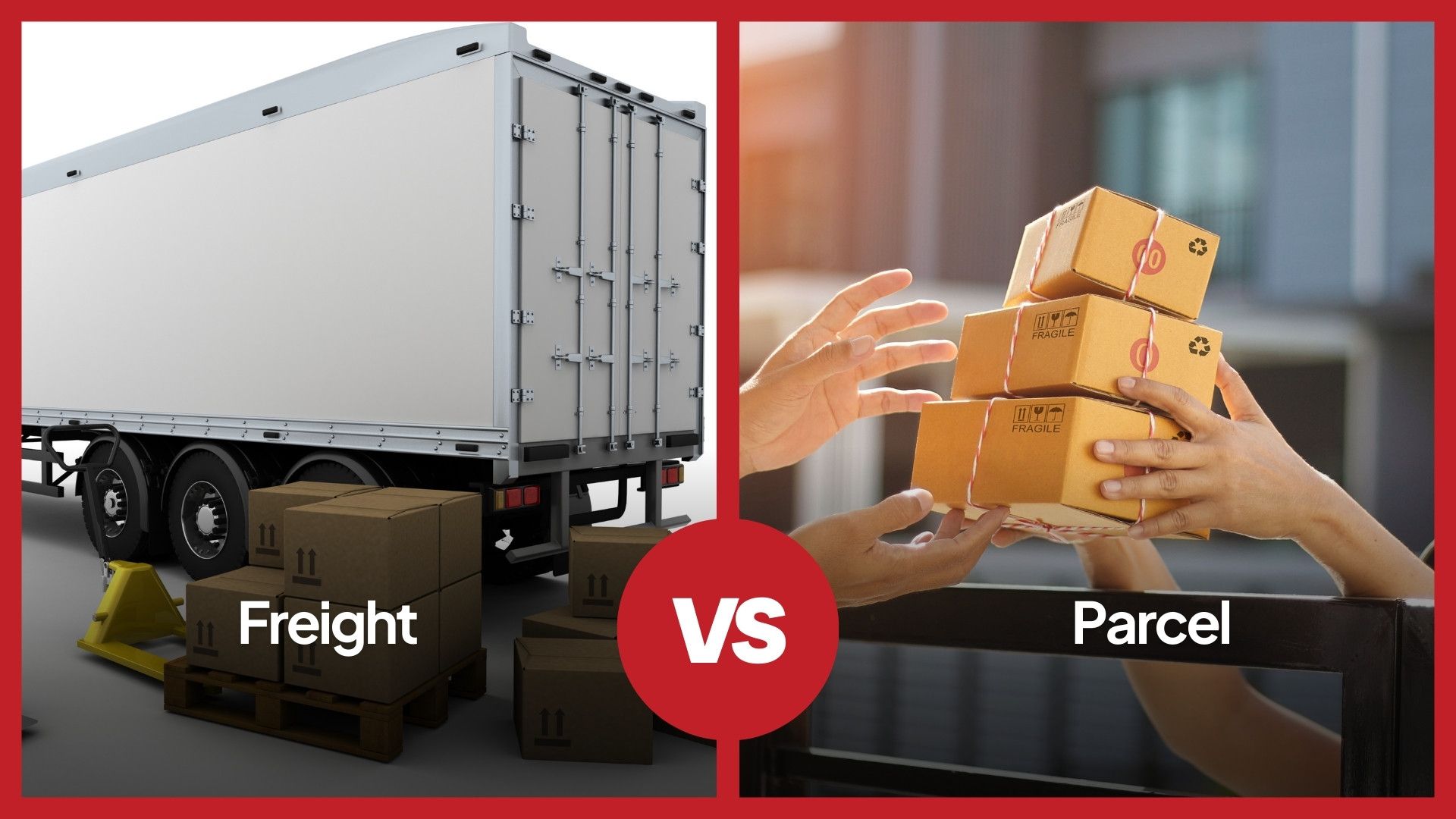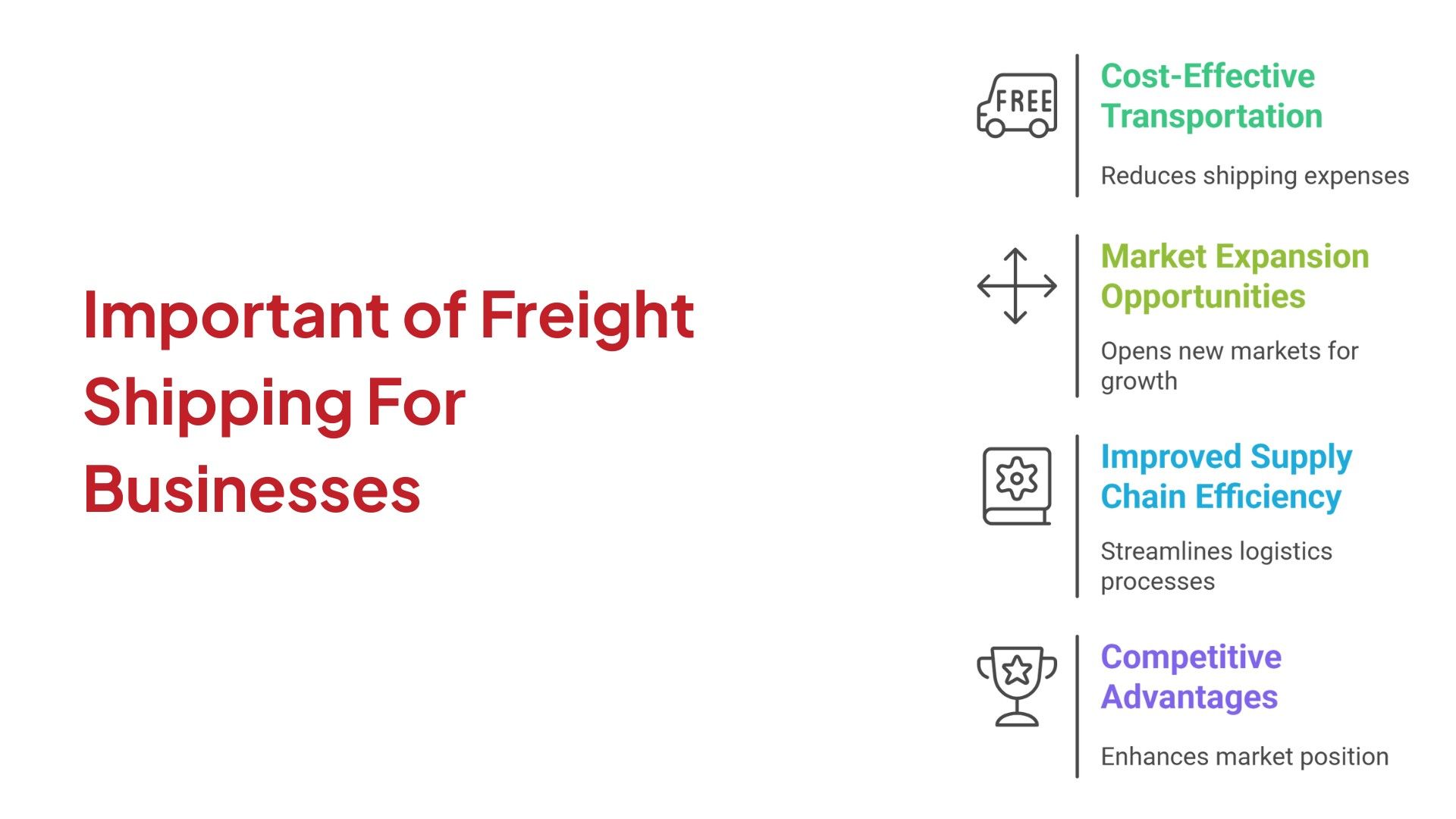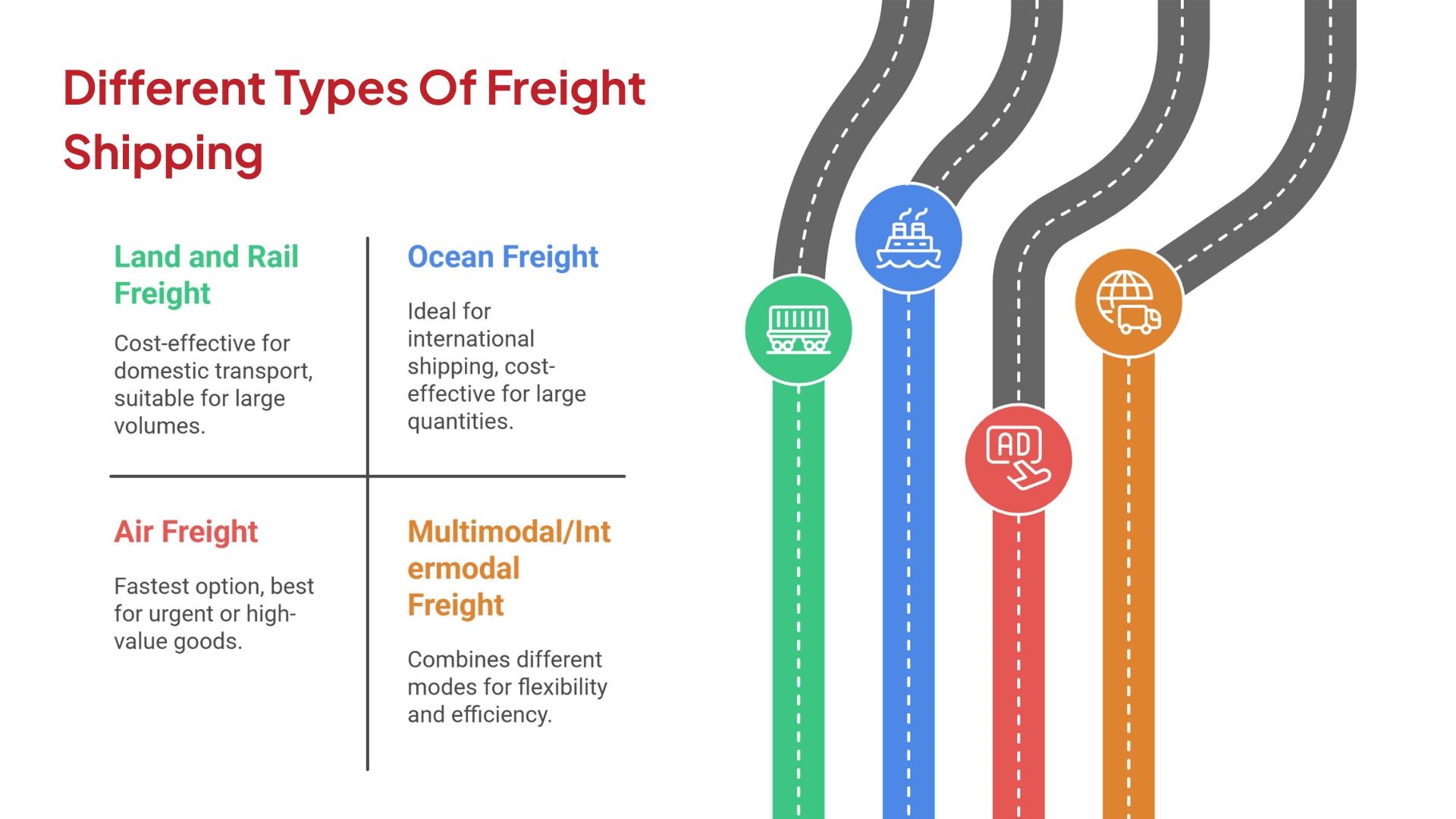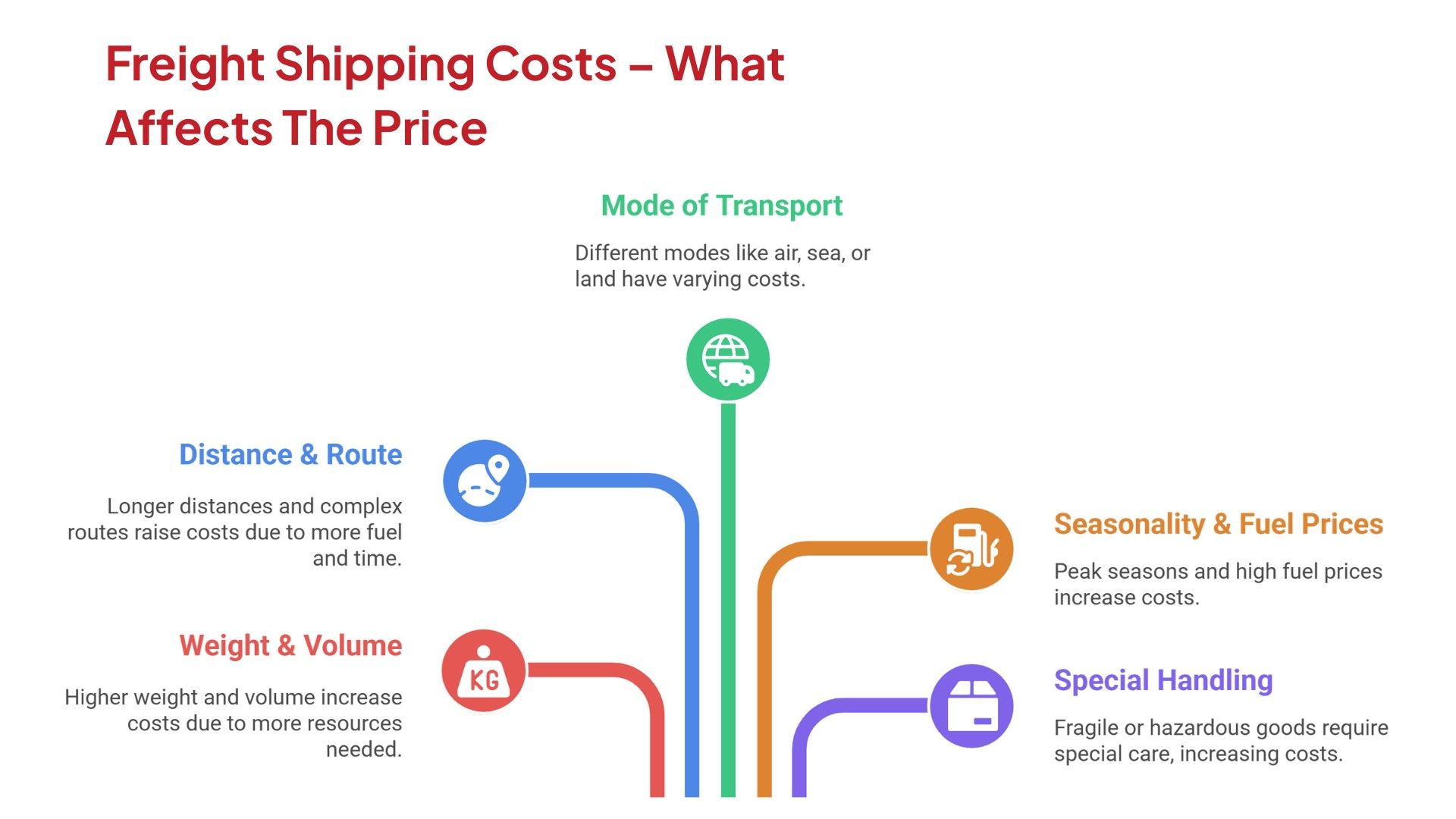
Moving goods from one place to another is at the heart of modern business. If you sell physical products, you've got to know how to get them from A to B without breaking the bank or your budget.
Freight shipping involves moving large quantities of goods using trucks, trains, ships, or planes.
Every time a business ships products, it faces a bunch of choices. Which shipping method? What's the price? And what about all that paperwork?
If you pick the wrong option, you'll face delays, broken goods, or costs that will eat into your profits.
What Is Freight Shipping?
Freight shipping moves heavy loads with trucks, trains, ships, or planes. It's not like sending a small box in the mail; these are the big, heavy shipments that regular parcel services can't handle.
In other words, it involves moving goods, commodities, and cargo by land, sea, or air, typically when the load exceeds 50 kg.
This kind of shipping connects manufacturers, suppliers, and buyers worldwide. It keeps global trade humming, from raw materials to finished products.
Key characteristics of freight shipping:
- Handles bulk quantities of goods
- Uses multiple transportation modes
- Supports business-to-business commerce
- Operates on scheduled routes and services
Difference Between Freight and Parcel Shipping

The big difference? Weight and size. Parcel shipping covers packages under 500 grams to 50 kg that fit in standard trucks.
Freight shipping jumps in when things get bigger or heavier. That means forklifts, pallets, and bigger vehicles.
Freight vs Parcel Shipping
Example:
- A furniture maker needs to ship 50 chairs to Delhi, which is not feasible via parcel shipping; therefore, it is classified as a freight job.
- Importing 10k mobile pieces from China requires freight shipments.
Why Freight Shipping Is Important For Businesses

The following are the reasons why freight shipping is important for businesses:
- Cost-Effective Transportation: The more you ship together, the less you pay per item compared to sending things one by one. Businesses can choose between full truckload or PTL transport as per their needs.
- Market Expansion Opportunities: State lines or borders don't limit where you sell. This opportunity is made possible by bulk shipping of stocks.
- Improved Supply Chain Efficiency: Freight carriers are specialized for all sorts of cargo, heavy machinery, hazardous materials, or items that need to stay cold.
- Competitive Advantages: Bulk shipments often mean lower per unit rates, which means lower shipping costs that can be passed to your customers.
Different Types Of Freight Shipping

It depends on what you're shipping, your budget, and how quickly you need delivery. These are the main types of freight shipments:
1. Land and Rail Freight
Land freight includes FTL and LTL freight shipping. Full Truckload (FTL) means you get the whole truck for your shipment. There is less handling and faster shipping as it goes straight to the receiver.
Less-than-truckload (LTL) is for smaller shipments. Your cargo shares space with others, and you only pay for the space you use.
Rail freight is great for moving lots of goods over long distances. Trains haul containers, bulk stuff, even cars, and can be 30-50% cheaper than trucking.
2. Ocean Freight
Like land freight, there are also two options: FCL and LCL.
Full Container Load (FCL) gives you a whole container—usually 20 or 40 feet long. Less Than Container Load (LCL) means you have to share a space in a container with other companies' stuff.
But the main disadvantage is that it takes a longer time, majorly 2 to 6 weeks, depending on the destination country and route.
3. Air Freight
You can move your inventory anywhere in the world in 1 to 3 days by air freight. There are two types of airlines: (a) cargo holds of passenger planes or (b) on dedicated freighters.
They are the most constant types of freight shipment and are usually used for express deliveries.
4. Multimodal/Intermodal Freight
Intermodal shipping keeps your cargo in the same container as it moves by truck, rail, and ship. No repacking needed. This saves money compared to using just one mode.
Freight Shipping Costs – What Affects The Price

Freight shipping prices depend on several factors. Let's discuss them one by one:
1. Weight & Volume
Carriers figure out shipping costs by looking at both actual and volumetric weight, then charge whichever is higher. That's the "chargeable weight" you see on invoices.
Volumetric weight uses a formula: Length × Width × Height ÷ Dimensional Factor.
If your shipment is light but takes up a lot of space—like a box of pillows—it might get billed as if it's way heavier.
2. Distance & Route
Longer trips mean more fuel, more driver hours, and more wear on vehicles. Another factor is regional shipping routes, as some routes just cost more. Remote deliveries also add a great margin to shipping costs.
3. Mode Of Transport
Every transportation mode comes with its own demerits—costs, speed, and sometimes unpredictability.
Among all, air freight is the most expensive but also the fastest. Conversely, ocean freight is the cheapest, but it is the slowest. Road and rail come in between.
4. Seasonality & Fuel Prices
Seasonality, such as during peak seasons, can cause the rates to shoot up by 20 to 50%.
In addition, fuel price also contributes to up to 50% of the total shipping cost. So, a rise in fuel prices can increase the freight shipping prices.
5. Special Handling Requirements
Some cargo needs extra care. For example, dairy products need temperature-controlled shipments and containers.
Oversized or heavy cargo requires additional permits and an escort team to ensure safe and careful transportation to the destination.
Furthermore, this extra attention requires special equipment, additional training, and unique procedures, all of which contribute to higher shipping costs.
Key Documents in Freight Shipping
Common Challenges In Freight Shipping
The following are the common challenges in freight shipments that a company owner might have to face.
- Rising Shipping Costs keep eating into profit margins. Fuel prices, surcharges, and limited capacity all push expenses higher.
- Delayed Shipments cause trouble up and down the supply chain. Weather, production issues, and port backlogs lead to missed deadlines.
- Lack of Visibility makes things worse. If you can't track your shipments, planning becomes a guessing game.
- Quality Control Problems hurt your reputation. Damaged goods or failed inspections result in returns and replacements, leading to financial losses and time waste.
- Customs and Compliance Issues slow down international shipments. Each country has its own paperwork and rules that must be followed.
- Capacity Shortages are another pain. Truck drivers, warehouse space, and equipment get strangled during busy seasons.
How To Choose The Right Freight Shipping Partner?

Picking a freight partner isn't just about price. You need to consider their network, special skills, tracking technology, compliance, and pricing.
- Carrier Network & Reach: Your logistic partner's network decides the final reach of your goods. You should choose a carrier that has a strong reach and at least offers pan-India reach, like AAJ Swift.
- Multimodal Capabilities: The best partners let you pick from road, air, and rail. This flexibility means you can choose the cheapest or fastest option for each shipment.
- Mode Specialization: Each freight needs specially skilled labor for loading/unloading and handling. So, must look for the experience that logistics companies have in dealing with those types of goods.
- Technology For Tracking: Modern partners provide real-time shipment tracking through GPS data, along with notifications for any delays. They should also have their own online portals to track the shipment status.
- Compliance With Regulations: Your shipping partner needs to be familiar with customs procedures, paperwork, customs brokerage services, and insurance coverage.
- Pricing & Service Levels: Freight pricing isn't just a base rate. It's a mix of fees, surcharges, and sometimes surprise costs. So, ensure your freight shipping partner adheres to your budget and shares transparent rate structures.
Ready to streamline your freight shipping? AAJ Swifts rolls out a complete freight solution with its Pan-India reach. Contact us today to discover customized rates and experience reliable logistics and PTL transportation.


